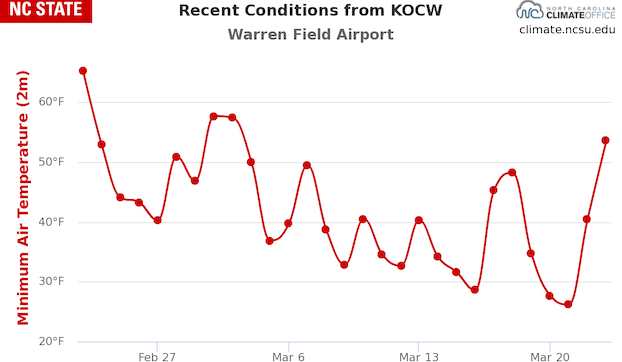Protecting your peaches during a cold snap
Published 5:12 pm Thursday, March 23, 2023

- The chart shows minimum air temperatures from Feb. 23- Mar. 23 at the Warren Field weather station. (NC State University Climate Office)
|
Getting your Trinity Audio player ready...
|
By Gene Fox
My Mam & Pap always said if March comes in like a lion, she goes out like a lamb but, if she comes in like a lamb, she is sure to go out like a lion! How about two good frosts in two days to start spring? So far, we have had a fairly warm spring. This unfortunately sets us up for devastation when we get cold weather again.
I checked my peaches Wednesday morning and I definitely had some damage from the cold temperatures. Peaches are pretty cool in that they will withstand temps down 27°/28°F before suffering widespread damage.
Sunday night (27.7°F) and Monday night (26.2°F) got pretty cold though. I pulled this data from the weather station at Warren Field, just across the way from my peaches. Remember though, this temperature is taken from two meters above the soil surface. There is typically a temperature inversion just below that mark where the temperature below it is colder.
How did I check them? Just pull a few blooms from around the tree and slice them right down the middle with a sharp knife or razorblade. Look for the ovary, if it is nice and green, you’re good but, if it is brown, the fruit has died from the cold.
What could we have done to protect against the cold? Master Gardener Volunteers took some precautions last week to help. First, we pulled the mulch back to expose the soil surface to the sun. This allows the soil to warm during the day and release that heat from under the trees to add a few degrees of cold protection. The other thing we did was to keep our trees watered really well. This helps the soil to warm and keeps the tree from being under any further stress. Where your trees are located can help as well in residential landscapes. My trees are exposed to first light from the sun which isn’t the best possible scenario. If they didn’t get the first morning light it would help to warm them gradually and protect the cells from bursting. Where my trees in the teaching garden are located, they warm up quickly which can cause the cells to burst and increase damage.
We could have also covered the trees. I wouldn’t recommend heading out to the local hardware store and buying plastic or tarps though. Head to the attic or garage or even Goodwill to look for some old sheets or blankets. The cloth covers are much better because they will allow gas exchange while still protecting the trees. Plastic will cause condensation which can actually have a cooling effect under it causing the environment inside the plastic to be colder. You can also buy row covers for garden plants, blueberries, or strawberries to keep the cold off of them.
So, what do I do now? Well, I don’t want my peaches to produce but 12-15% of those peaches anyway. So, this isn’t necessarily a bad thing. The cold conditions will help me thin the fruit off the tree. I purposely wait to thin fruit in warmer years in anticipation of an even such as this so I won’t lose as much. If I had already thinned my fruit I would be in trouble. As it is, I believe that I have lost about 2/3 of the peaches so right now, I am in good shape. However, I don’t want to lose anymore!!
If you would like more information on growing home lawns, sign up for my class March 31. This is a part of the “What you need TO KNOW so you can GROW” series that will be taught every Friday from 9-11:00 a.m. throughout March. Please call the office for more information and to register for the classes.
If you are having trouble with growing in your home landscape, call the Extension office at (252)946-0111 or email me at gene_fox@ncsu.edu. Save the date for April 8 for the “Growing Tomatoes Successfully” class. Participants will get a presale shot at buying vegetables! April 15th at 9:00 when the Extension Master GardnerSM Volunteers will be having their annual vegetable transplant sale. Until then, Happy Gardening!



